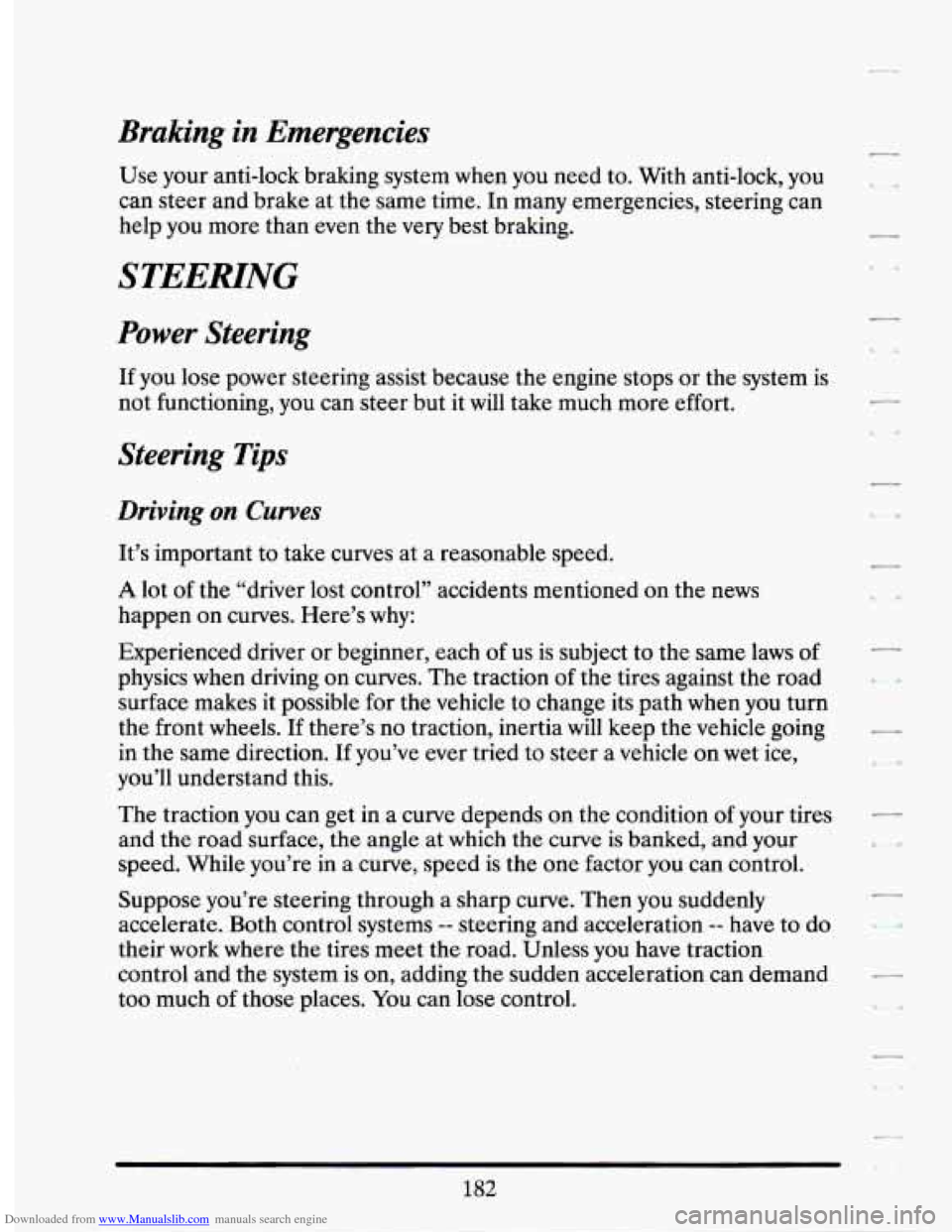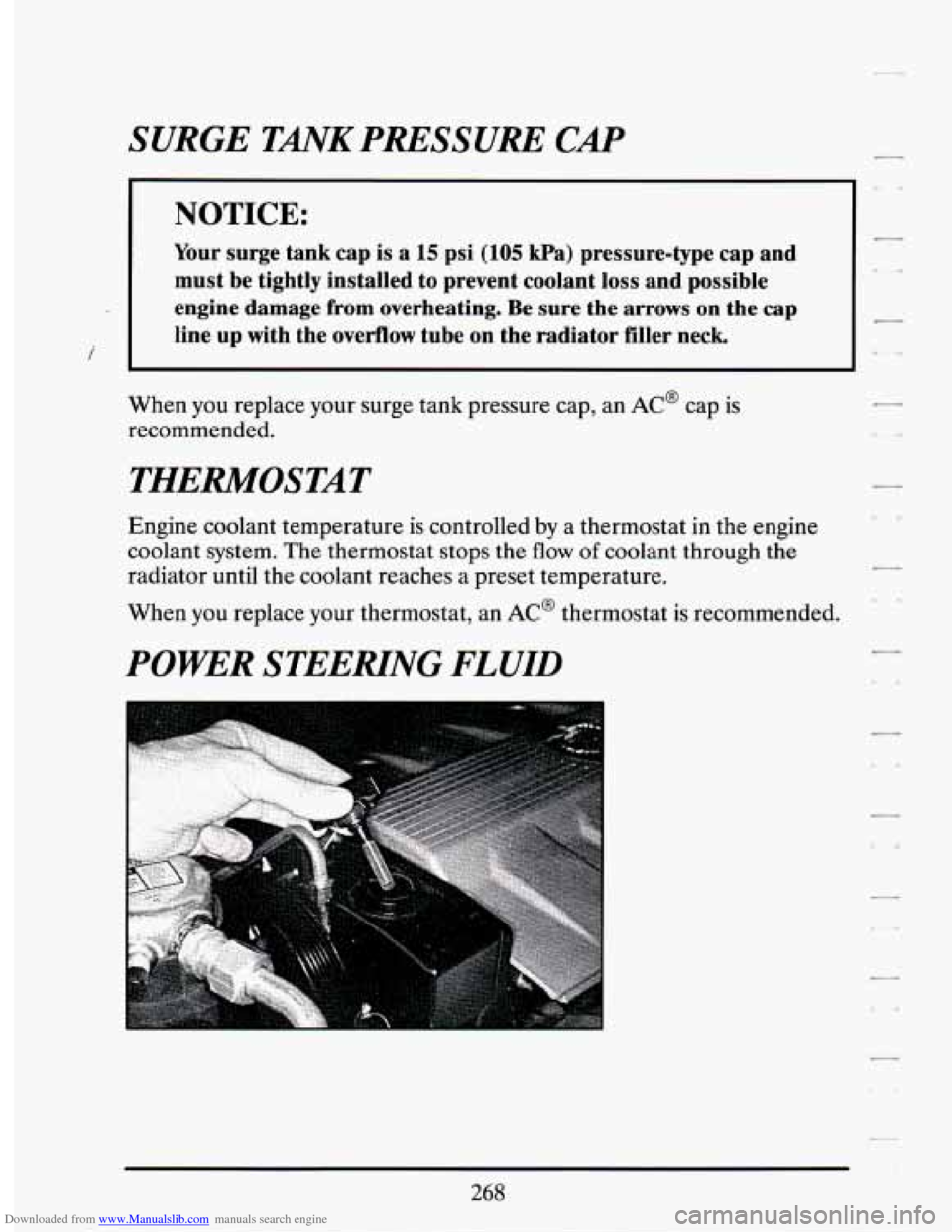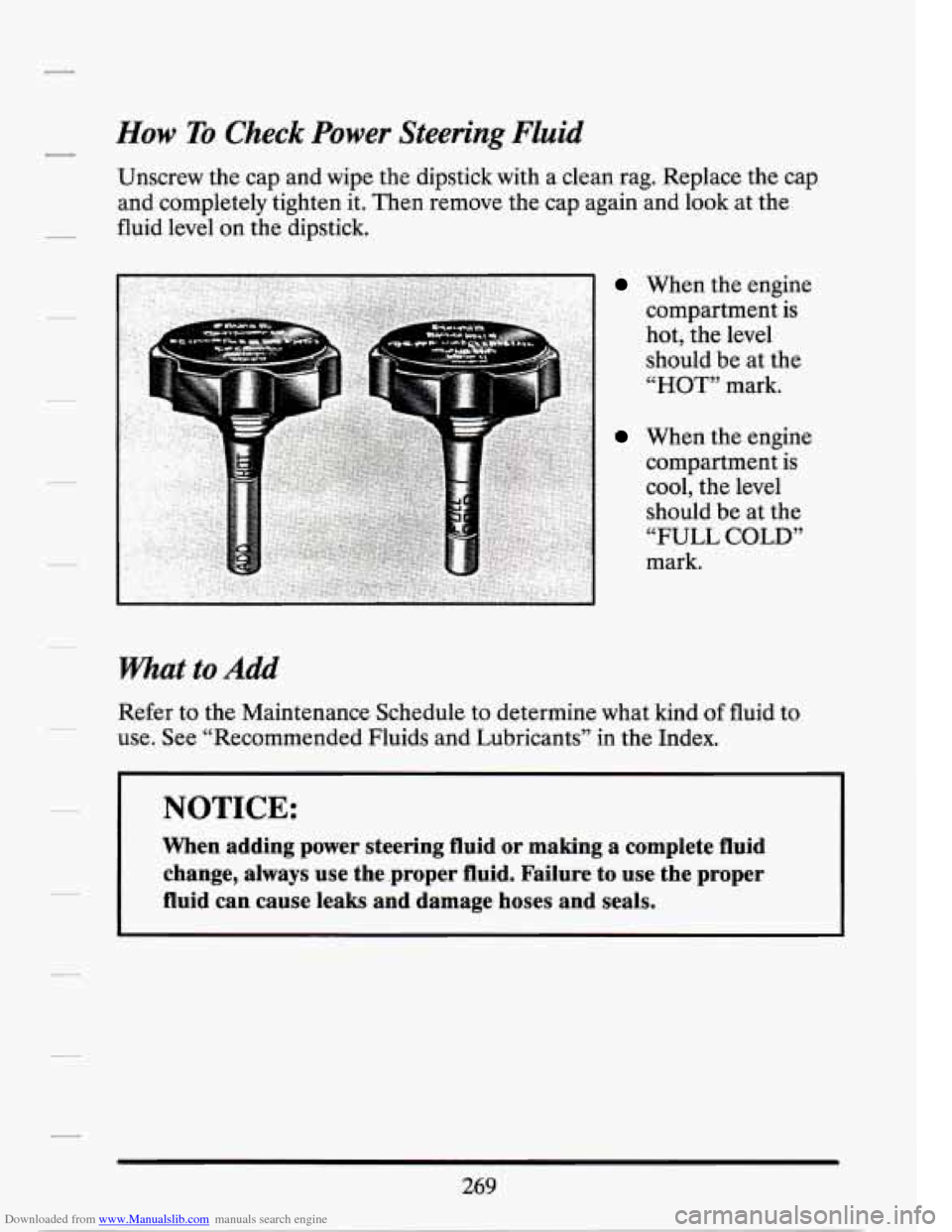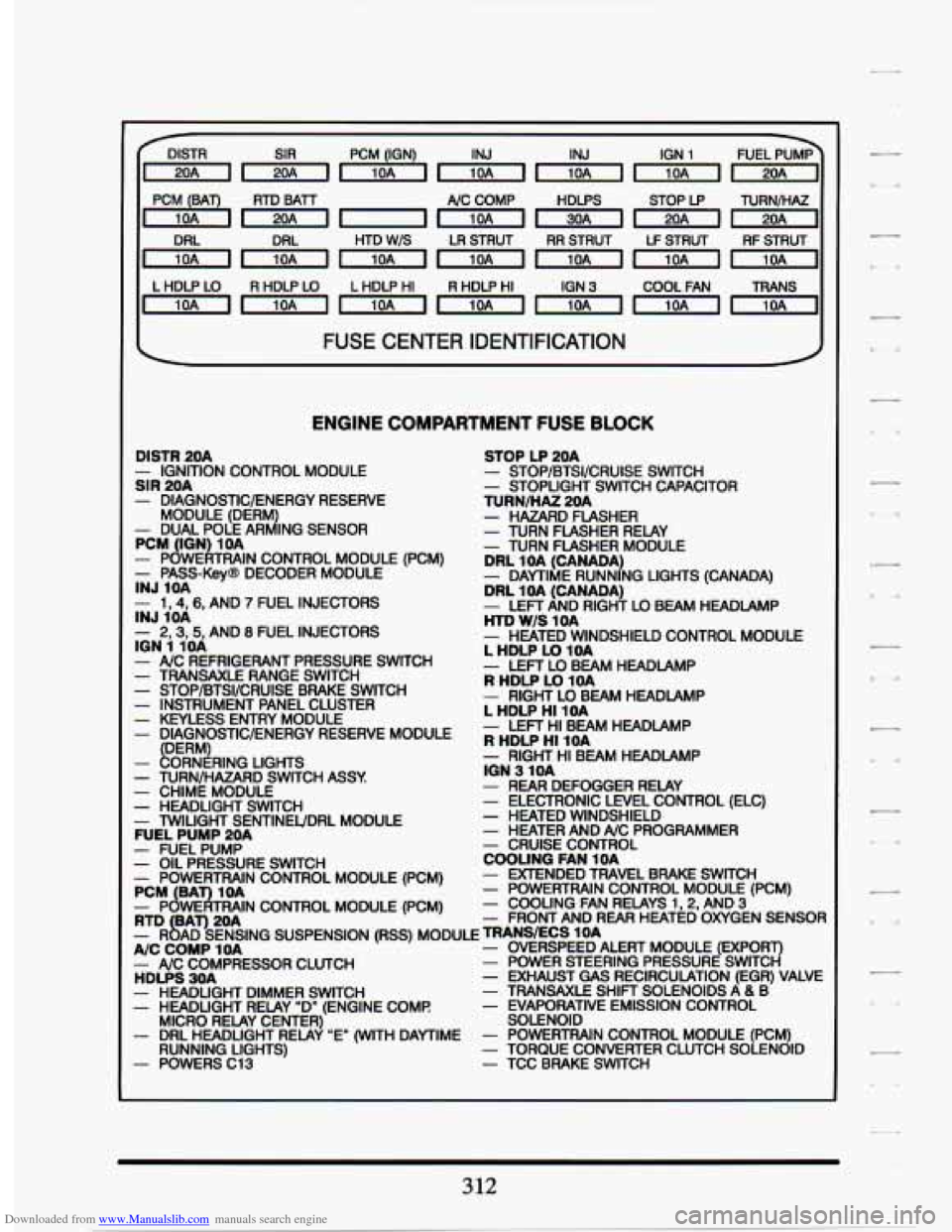1994 CADILLAC SEVILLE power steering
[x] Cancel search: power steeringPage 114 of 399

Downloaded from www.Manualslib.com manuals search engine POKER WINDOWS
The controls are near
each window. Here’s
how the master control
works.
Your vehicle has Retained Accessory Power
(RAP). When you stop your
vehicle and turn the ignition
key to “Off”, you can still use your power
windows. The electrical power to operate the windows will not shut
off
until you open a door or 10 minutes has passed. If you want this power
for another
10 minutes, just turn the key to “Run” and back to “Off”.
Express Down Window
The driver’s power window has this feature. Just press the switch
rearward once
-- for half a second or more -- and then let go. The window
will lower completely.
If you want to stop the window as it is lowering,
press the switch again.
To raise the window, press and hold the switch
forward.
HORN
To sound the horn, just press the center of the steering wheel.
101
Page 195 of 399

Downloaded from www.Manualslib.com manuals search engine Braking in Emergencies
Use your anti-lock braking system when you need to. With anti-lock, you
can steer and brake at the same time. In many emergencies, steering can
help you more than even the very best braking.
STEERTNG
Power Steering
If you lose power steering assist because the engine stops or the system is
not functioning, you can steer but it will take much more effort.
Steering Tips
Driving on Curves
It’s important to take curves at a reasonable speed.
A lot of the “driver lost control” accidents mentioned on the news
happen
on curves. Here’s why:
Experienced driver or beginner, each of us is subject to the same laws
of
physics when driving on curves. The traction of the tires against the road
surface makes
it possible for the vehicle to change its path when you turn
the front wheels.
If there’s no traction, inertia will keep the vehicle going
in the same direction. If you’ve ever tried to steer a vehicle on wet ice,
you’ll understand this.
The traction you can get in a curve depends on the condition of your tires
and the road surface, the angle at which the curve is banked, and your
speed. While you’re in a curve, speed is the one factor you can control.
Suppose you’re steering through a sharp curve. Then you suddenly
accelerate. Both control systems
-- steering and acceleration -- have to do
their work where the tires meet the road. Unless
you have traction
control and the system is on, adding the sudden acceleration can demand
too much of those places. You can lose control.
182
Page 281 of 399

Downloaded from www.Manualslib.com manuals search engine SURGE TANK PRESSURE CAP
1 NOTICE:
Your surge tank cap is a 15 psi (105 kPa) pressure-type cap and
must be tightly installed to prevent coolant loss and possible
engine damage from overheating. Be sure the arrows on the cap \
line up with the overflow tube on the radiator filler neck.
i
When you replace your surge tank pressure cap, an AC@ cap is
recommended.
THERMOSTAT
Engine coolant temperature is controlled by a thermostat in the engine
coolant system. The thermostat stops the
flow of coolant through the
radiator until the coolant reaches a preset temperature.
When you replace your thermostat, an
AC@ thermostat is recommended.
POWER STEERING FLUID
268
Page 282 of 399

Downloaded from www.Manualslib.com manuals search engine How To Check Power Steering Fluid
Unscrew the cap and wipe the dipstick with a clean rag. Replace the cap
and completely tighten it. Then remove the cap again and look at the
fluid level on the dipstick.
When the engine
compartment is
hot, the level
should be at the
“HOT” mark.
When the engine
compartment
is
cool, the level
should be at the
“FULL COLD”
mark,
What to Add
Refer to the Maintenance Schedule to determine what kind of fluid to
use. See “Recommended Fluids and Lubricants” in the Index.
NOTICE:
When adding power steering fluid or making a complete fluid
change, always use the .proper fluid. Failure to use the proper
fluid can cause leaks and damage hoses and seals.
269
Page 325 of 399

Downloaded from www.Manualslib.com manuals search engine DISTR PCM (IGN) IGN 1
, PC';":"), RTD BATT
~-1nmmmrl
A/C COMP HDLPS STOP LP TURNIHAZ
HTD
W/S LR STRUT RR STRUT LF STRUT RFSTRUT
LHDLPLO RHDLPLO LHDLPHI RHDLPHI
IGN
3 COOL FAN TRANS
~mmmrnmm~
FUSE CENTER IDENTIFICATION I
ENGINE COMPARTMENT FUSE BLOCK
DISTR 20A
SIR 20A - IGNITION CONTROL MODULE
- DIAGNOSTIC/ENERGY RESERVE
- DUAL POLE AR d ING SENSOR
MODULE (DERM PCM
(ION 1OA - PowEATmIN CONTROL MODULE - PASS-KevB DECODER MODULE INJ 1OA
- 1,4,6, AND 7 FUEL INJECTORS
- 2,3,5, AND 8 FUEL INJECTORS
- - - - - __ -
INJ 1OA
ION 1 1OA
- NC REFRIGERANT PRESSURE SWITCH ~~ ~
- TRANSAXLE RANGE SWITCH - STOP/BTSI/CRUISE BRAKE SWITCH - INSTRUMENT PANEL CLUSTER - KEYLESS ENTRY MODULE - DIAGNOSTWENERGY RESERVE MODULE
FERMl ~ ~. - ORN RING LIGHTS
- TURN/HAZARD SWITCH ASSY - CHIME MODULE - HEADLIGHT SWITCH - mlUGHT SEUTINEUDRL MODULE FUEL PUMP 20A
STOP LP 20A - STOP/BTSI/CRUISE SWITCH - STOPLIGHT SWITCH CAPACITOR TURN/HAZ 20A - HAZARD FLASHER - TURN FLASHER RELAY - TURN FLASHER MODULE ~ ~~ ~ ~~ DRL 1 OA (CANADA)
DRL 1OA (CANADA)
HTD
W/S 1OA
- DAMIME RUNNING LIGHTS (CANADA)
- LEFT AND RIGHT LO BEAM HEADLAMP
- HEATED WINDSHIELD CONTROL MODULE L HDLP LO 10A
R HDLP LO 1OA - LEFT LO BEAM HEADLAMP
- RIGHT LOBEAM HEADLAMP L HDLP HI 10A
R HDLP HI 1OA - LEFT HI BEAM HEADLAMP
- RIGHT HI BEAM HEADLAMP ION 3 -1 OA - REAR DEFOGGER RELAY - ELECTRONIC LEVEL CONTROL (ELC) - HEATED WINDSHIELD - HEATER AND A/C PROGRAMMER
COOLING FAN 10A - CRUISE CONTROL
- EXTENDED TRAVEL BRAKE SWITCH - POWERTRAIN CONTROL MODULE (PCM) - COOLING FAN RELAYS 1.2. AND 3
- PUMP^
- OIL PRESSURE SWITCH - POWERTRAIN CONTROL MODULE (PCM)
- POWERTRAIN CONTROL MODULE (PCM) PCM (BAT) 1OA
RTD BAT) 20A - FRONT AND REAR HEATED-OXYGEN SENSOR
A/C COMP 10A
HDLPS 3OA - EXHAUST GAS RECIRCULATION (EGR) VALVE
- SENSING SUSPENSlON (RSS) MODULE MODULE (EXPORT)
- NC COMPRESSOR CLUTCH - POWER STEERING PRESSURE SWITCH
- HEADLIGHT DIMMER SWITCH - TRANSAXLE SHIFT SOLENOIDS A & B - HEADLIGHT RELAY "D" (ENGINE COME - EVAPORATIVE EMISSION CONTROL
- DRL HEADLIGHT RELAY "E" (WITH DAYTIME - POWERTRAIN CONTROL MODULE (PCM)
- POWERS C13 - TCC BRAKE SWITCH
MICRO RELAY CENTER)
SOLENOID
RUNNING LIGHTS) - TORQUE CONVERTER CLUTCH SOLENOID
312
Page 336 of 399

Downloaded from www.Manualslib.com manuals search engine The suspension system also incorporates a new damping system know as
Road Sensing Suspension. This system control the damping forces in the
shock absorbers and struts, in response to various road and driving conditions.
The systems are capable
of making these damping changes extremely fast.
A computer receives inputs from vertical acceleration sensors, whee\
l to body
position sensors, vehicle speed sensor, lift and dive signals. This computer
evaluates the inputs from these sensors, to control the damping of each
of the
struts and shocks independently to provide varied levels
of suspension control.
The system also has the capability of providing Speed Sensitive Steering
control. This system changes your steering effort based on your vehicle speed.
Speed Sensitive Steering
This system varies the amount of steering effort proportionate to your vehicle
speed. Steering is easier at a lower speed for increased maneuverability and
parking
ease. As your vehicle speed increases, the steering effort is also
increased to provide a manual like steering feel for maximum control and
enhanced vehicle stability.
The power rack and pinion steering system has a rotary spool valve\
which
directs hydraulic fluid coming from the power steering pump to one side or
the other side
of the rack piston. The integral rack piston is attached to the
323
Page 337 of 399

Downloaded from www.Manualslib.com manuals search engine rack. The rack piston converts hydraulic pressure to a linear force which
moves the rack left or right. The force is then transmitted through the
inner and outer tie rods to the steering knuckles, which turn the wheels.
If hydraulic assist is not available, manual control is maintained. However
under these conditions more steering effort is required.
4.6 LITER NORTHSTAR ENGINE
Displacement ............................... .4.6L (279 cu.in.)
No. of Cylinders .............................. 8 - 90 Degree V
Power (ACC. to
SAE 51349) ............... 270 (bhp) @ 5600 rpm
Torque (ACC. to
SAE 51349) ............ 300 (lbs. ft.) @ 4000 rpm
SLS
...................................... 204 (kW) @ 5600 rpm
...................................... 407(N*m) @ 4000 rpm
STS
Power (ACC. to SAE 51349) .1. ............ 295 (bhp) @ 6000 rpm
Torque (ACC. to
SAE 51349) ............ 290 (lbs. ft.) @ 4400 rpm
...................................... 220 (kW) @ 6000 rpm
...................................... 393 (Nom) @ 4400 rpm
Bore
........................................ 93mm (3.66 in.)
Stroke
...................................... .84mm (3.31in.)
Compression Ratio
................................... 10.3:l
Cylinder Heads
............................... Cast Aluminum
Cylinder Block
...... Die Cast
Aluminum with Iron Cylinder Bores
Intake Manifold
............ Die Cast Magnesium / Thermoplastic
........................................ Air Induction Tubes
Valve System
................... Direct Acting Hydraulic Tappets
Intake Valve
................................. 33mm (1.29 in.)
Exhaust Valve
................................ 29mm (1.14 in.)
Firing Order
.................................. 1-2-7-3-4-5-6-8
Pistons
...................................... Cast Aluminum
Left Bank
.......................................... 2-4-6-8
324
Page 340 of 399

Downloaded from www.Manualslib.com manuals search engine FLUID CAPACITIES
Transaxle (4T80E) .............................. 30 pts. (14 L)
Engine Oil
................................... 7.0 qts. (6.6 L)
With Filter Change
............................ 7.5 qts. (7.2 L)
Engine Cooling System ....................... 12.5 qts. (11.8 L)
Fuel Tank .................................. 20 gallons (76 L)
Power Steering
.............................. 1.3 quarts (1.2 L)
Windshield Washer Reservoir
.................. 4.2 quarts (4.1 L)
TIGHTEN TORQUE
Spark Plugs ................................ 15 Nom
Oil Pan Drain Plug
.......................... 20N-m
VEHICLE DIMENSIONS
(11 lbs. ft.)
(15 Ibs. ft.)
SLS/STS
Shipping Weight (SLS)
Shipping Weight (STS)
Wheel Base
..........
Length ..............
Height ..............
Width ...............
.................... 3740 lbs. (1696.4 kg)
.................... 3802 lbs. (1724.3 kg)
...................... 111 in. (2819 mm)
.................... .204.1 in. (5183 mm)
..................... .54.5 in. (1384 mm)
..................... .74.2 in. (1884 mm)
Front Track
............................... .60.9 in. (1546 mm)
Rear Track
............................... .60.9 in. (1546 mm)